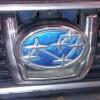Search the Community
Showing results for tags 'E-85'.
-
As the title says... I'm converting to E-85. I need a little help. I've looked around on USMB, but haven found the info i need. (Just a lot of political stuff .) So here's what I know. E-85 has a stoichiometric value (air fuel ratio) of about 9.8 to 1 and Gas is 14.7 to 1. The carburetor meters the fuel with the jets. The number stamped on the jet refers to the diameter in hundredths of a millimeter (0.01mm). A 155 main jet, for example, has a hole of 1.55mm in diameter. Larger numbers make the engine run richer (more fuel). Simple stuff... Using some math we can figure the area of the jet ( π r 2 ) and use a ratio calculation to get my new jet size. So take my 106 jet; the radius of 1.06mm is 0.53mm (1.06/2). Times it self, 0.53 x 0.53 = 0.2809 (r 2 ). Next, 0.2809 x π = 0.882473 mm2. A 106 jet has a surface area of 0.882473 mm2. Now, ratio calculation: 0.882 x 14.7 = 12.9724... 12.9724 / 9.8 = 1.3237 I need a jet with the area of 1.3237. Reverse the ( π r 2 ) formula and it turns out, I need a 130 jet to replace the 106. Drill out my jet to 1.3mm and presto! I have a Hitachi carburetor capable of running E-85. Not so simple... Feel free to check my math. Here are my questions... The Hitachi has eleven jets. Which ones do i drill out? Only the primary jet and the secondary jet (someone mentioned)? AND how do I identify which one is the primary and which one is the secondary? Are those the ones on the bottom of the float bowl? Or do I drill all eleven?
- 3 replies
-
- alternative fuel
- E-85
-
(and 1 more)
Tagged with:



